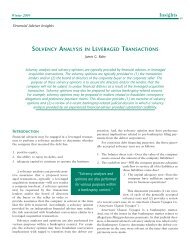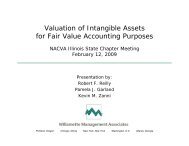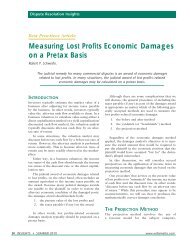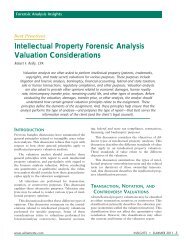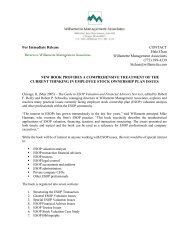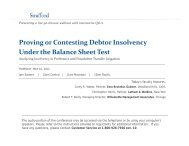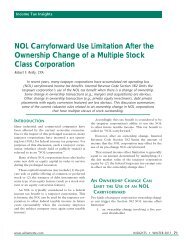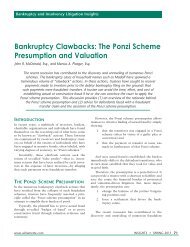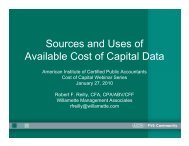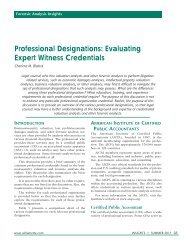View PDF - Willamette Management Associates
View PDF - Willamette Management Associates
View PDF - Willamette Management Associates
- No tags were found...
Create successful ePaper yourself
Turn your PDF publications into a flip-book with our unique Google optimized e-Paper software.
■ The company is either relatively newor has experienced a recent period of negativeoperating results.■ A buyer or stock acquisition financingsource wants to know the debt collateralvalue of the company assets.■ A buyer or financing source wants toknow the post-financing solvency of thecompany.■ A third party wants to know what thepost-transaction company fair value balancesheet will look like if the stock purchaseresults in a change of control.■ A buyer wants to know why it is beingasked to pay a multiple of earnings or amultiple of book value for the private company;in other words, what operating assetsare the investors buying in the stock purchasetransaction?In order to perform an asset approachvaluation, an analyst has to identify andvalue the following categories of assets andliabilities:■ Net working capital (e.g., accountsreceivable and inventory)■ Tangible personal property (e.g.,machinery and equipment)■ Real estate (e.g., land and buildings)■ Identifiable intangible assets (e.g.,patents, copyrights, trademarks, licensesand permits, computer software, customerrelationships)■■■Intangible value in the form of goodwillContingent liabilitiesRecorded liabilities.The following are some caveats to correctthe misconceptions that many valuationanalysts—and many CPAs—holdabout the asset approach:■ It does not conclude a liquidation valuein the company; rather, all of the tangible andintangible assets are valued on a continueduse/going concern basis, so the concludedbusiness value is a going concern value.■ It does not consider tangible assets only;rather, in most successful companies, mostof the business value relates to identifiedintangible asset value and to goodwill.■ It does not rely on speculative valuesfor intangible assets; rather, these valuesare exactly the same as those that wouldbe recorded on audited GAAP financialstatements as the result of a purchase priceallocation.■ It does not result in the net book valueconclusion as reported in the company’s balancesheet; rather, a pre–fair value balancesheet and a post–fair value balance bear littlerelationship to each other.■ The most common asset approachvaluation methods include the asset accumulationmethod and the adjusted net assetvalue method.The typical asset approach valuation formulais summarized as follows:working capital value+ tangible assets value+ intangible assets value= total assets value– recorded liabilities value– contingent liabilities value= private company equity valueIn addition to valuing a company’sintangible assets, an analyst also has to identifyand quantify any off–balance sheetcontingent liabilities. Such liabilitiesinclude lawsuits, environmental concerns,and similar items.Typically, the asset approach will indicatea company’s total equity value on a marketable,controlling interest level of value.At this stage of a private stock valuation,an analyst will typically adjust all ofthe indicators to be on the same level ofvalue. Then, the analyst will synthesize(i.e., weight) the income, market, and (ifperformed) asset approach value indicatorsin order to reach one final value conclusionfor the private company. This weightingis based on the analyst’s assessment ofthe quantity and quality of available data,the applicability of each approach to thecompany, and the range and reasonablenessof the various value indicators.To simplify the discussion, assume thatan analyst has concluded the company’stotal equity value. In practice, there istypically an intermediate procedure inwhich the analyst first concludes thecompany’s invested capital value. Fromthis invested capital, the analyst subtractsthe company’s long-term interest bearingdebt, to reach the total equity value. Fromthis total equity value amount, the analystsubtracts the value of any company preferredstock to conclude a preliminary commonequity value. The analyst adjusts thetotal common equity value for the proceedsfrom any in-the-money stock options.The analyst then concludes the final totalequity value (and the number of outstandingcompany shares, including exercisedin-the-money options). This procedure istypically called a waterfall analysis.Levels of ValueThe term “level of value” refers to twoinvestment criteria regarding private companystock:■ Marketable versus nonmarketable—thiscriterion indicates how easy it is for theshareholder to sell stock and convert thatinvestment into cash.■ Control versus lack of control—this criterionindicates how much control theshareholder has over the company’s businessoperations and strategic direction.Many valuation analysts (and manyCPAs) believe that there are only three separateand independent levels of value:■ Marketable, controlling ownershipinterest (e.g., one shareholder owns 100%of the closely held corporation)■ Marketable, noncontrolling ownershipinterest (e.g., as if the closely held corporationstock was publicly traded on a stockexchange)■ Nonmarketable, noncontrolling ownershipinterest (e.g., stockholder shareholderowns a small block of stock in the closelyheld corporation)In truth, the above-listed levels of valuerepresent a gross oversimplification. For allcompanies, these two investment criteriaeach exist on a continuum. Exhibit 1 moreaccurately reflects the level of value considerationsthat an investment analyst shouldassess with regard to company stock:Where the subject block of stock falls inthis X axis and Y axis continuum is a functionof the following factors:■ The absolute size of the block ofstock■ The relative size of the block of stock(compared to other stockholders)■ The relative voting rights and policiesof the private company■ The state in which the private companyis incorporated■ The absolute number of directors on theboard and the rotation of board elections■ The potential for a corporate liquidityevent (e.g., an initial public offering,stock tender offer)■ The ability of a plan participant to putshares back into the company■ The contractual rights of the block ofstock (e.g., come-along rights, tag-alongrights, rights of first refusal, registrationrights)■ The history of private transactions inthe company stockJANUARY 2012 / THE CPA JOURNAL 49



